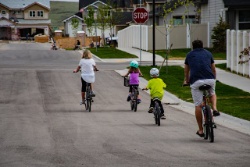Rethink urged on injury measurement
Rethink urged on injury measurement for Safe Communities
Injury Prevention network of Aotearoa New
Zealand
media release 9 October 2009
Injury prevention researchers from the Injury Prevention Research Unit at the University of Otago are questioning how communities are expected to measure the “injury outcomes” which the World Health Organization (WHO) requires of designated Safe Communities and say there are better ways to set priorities and gauge the success of local injury prevention programmes.
New Zealand currently has nine designated International Safe Communities under the WHO sponsored network, with at least 12 more pending accreditation.
The rationale behind the WHO’s requirement is to encourage communities to develop prevention strategies for specific local injury problems and to enable programmes to evaluate their effectiveness.
However, Jean Simpson told the Injury Prevention Network Conference at Hoani Waititi Marae in Waitakere today that for most Safe Communities the number of injuries occurring in a community may not reflect how well injury prevention programmes are actually working.
“When a child is killed or injured in a car crash it is a terrible tragedy, especially if they were not properly restrained in a car seat. However, at a community level, this is a relatively rare event. That makes collecting the number of these events happening to evaluate your success over an extended period of time unreliable.
“If you base your injury prevention priorities only on your local data, you might not include child injury from car crashes if there haven't been any in your community in the last few years. That makes no sense because we know it’s important at a national level and very costly to the child, their family and to society.”
Ms Simpson said when they looked at the data for injury deaths and hospitalisations from Safe Communities in New Zealand they found that most would struggle to show their programmes had a positive impact on the number of injuries that were occurring.
“There can be a real problem with data over time. For example, some injuries are treated differently now than they used to be and people may be sent home instead of staying in hospital. So just because there are fewer hospitalisations now than there were five years ago may not mean the injuries are occurring any less.”
Ms Simpson said these sorts of difficulties made the WHO requirement to measure injury outcomes unrealistic for many Safe Communities and that a better use of their scarce resources would be measuring the effect of interventions known to reduce injury.
“Focusing on what can be reliably measured such as how many parents are using the child safety seat correctly will give more useful information on how effective the programme is than calculating the rate of children injured or killed in car crashes.”
Ms Simpson said other useful measures related to road safety might include seatbelt use, speeding, bicycle helmet wearing and alcohol misuse, all of which are known to impact on injury.
The nine centres in New Zealand accredited by the World Health Organization as Safe Communities are Waitakere, Waimakariri, New Plymouth, Whangarei, Wellington, North Shore, Tauranga, Porirua and Christchurch.
Pending accreditation are Masterton, Carterton, South Wairarapa, Napier, Taupo, Rotorua, Wanganui, Hutt City, Upper Hutt, Gisborne, Nelson and Tasman.
-Ends-


 FASD-CAN: People With Fetal Alcohol Spectrum Disorder (FASD) Dismayed At Government’s Response To The Rights Of Disabled People
FASD-CAN: People With Fetal Alcohol Spectrum Disorder (FASD) Dismayed At Government’s Response To The Rights Of Disabled People NZ Opera: Jane Austen Opera Coming To Christchurch & Dunedin - South Island Premiere | NZ Opera’s Mansfield Park Returns This April
NZ Opera: Jane Austen Opera Coming To Christchurch & Dunedin - South Island Premiere | NZ Opera’s Mansfield Park Returns This April Sport Manawatū: Women’s Health Series Empowers Women To Prioritise Their Wellbeing
Sport Manawatū: Women’s Health Series Empowers Women To Prioritise Their Wellbeing Pure Adventure Charitable Trust: Iconic One New Zealand GODZONE To Make Triumphant Return To New Zealand’s Adventure Racing Scene
Pure Adventure Charitable Trust: Iconic One New Zealand GODZONE To Make Triumphant Return To New Zealand’s Adventure Racing Scene The Charter School Agency: New Charter Schools Open Doors To First Students
The Charter School Agency: New Charter Schools Open Doors To First Students  The Wednesday Challenge: Tauranga Travel Initiative Goes National
The Wednesday Challenge: Tauranga Travel Initiative Goes National